Abstract
New homogeneous bilayer membranes with a thin anion-exchange layer have been developed based on the copolymer of N,N-diallyl-N,N-dimethylammonium chloride (DADMAC) and ethyl methacrylate (EMA) on the surface of a membrane substrate made from polyfluorosulfonic acid (PFSA). The overall and partial current–voltage characteristics, as well as external and internal diffusion-limiting currents, were theoretically and experimentally investigated. Parameters such as specific conductivity, sorption, and diffusion permeability of individual membrane layers were determined, along with effective transport numbers and specific permselectivity of the bilayer homogeneous membranes in mixed solutions of calcium chloride and sodium chloride. It was found that applying a thin anion-exchange layer of DADMAC and EMA to the homogeneous membrane allows for the creation of a charge-selective bilayer membrane with enhanced selectivity toward monovalent metal cations. The specific selectivity of the bilayer membrane for sodium cations increases more than 6-fold (from 0.8 to 4.8). Verification of the obtained experimental data was performed within a four-layer mathematical model with quasi-equilibrium boundary conditions for the diffusion layer (I)/modifying layer (II)/membrane substrate (III)/diffusion layer (IV) in ternary NaCl+CaCl2 solutions.
1. Introduction
Ion-exchange membranes find widespread use in processes like desalination, deionization, electrolyte concentration, and reagentless pH control of industrial solutions []. They are also employed for salt recovery into acids and alkalis using bipolar membranes []. Recent years have seen a surge in research focused on electrodialysis-based ion separation, driven by the emergence of new applications. These include reverse electrodialysis [,], metathesis electrodialysis [], and membrane capacitive deionization []. Ion separation processes are critical for flow redox batteries [], microbial fuel cells [], and the development of targeted drug delivery systems []. Electrodialysis is especially important for establishing closed-loop production in chemical, biochemical, and medical industries, food production [], hydrometallurgy [,], and thermal and nuclear power [].
A key challenge in electrodialysis technology is creating membranes with high selectivity for specific ions within multi-ionic solutions. Surface modification [] is the primary approach, involving the formation of a thin selective layer on the surface of isotropic ion-exchange membranes []. This process results in anisotropic membranes, either bilayered [] or multilayered [].
Ran et al. [] briefly address ion-exchange membrane selectivity in their review, while Luo et al. [] offer a detailed analysis of the topic. Xu et al. [] published a monograph focused on monovalent-selective cation-exchange membranes, exploring traditional and innovative preparation and modification methods.
In co-ion separation, where a layer of ion polymer with opposite matrix charge is applied, the separated ions act as counterions for the substrate membrane and co-ions for the modifying layer. The stronger electrostatic interaction of multivalent ions with the modifying layer’s polymer matrix is the primary separation mechanism, while physicochemical interactions play a lesser role.
This process often leads to a decrease in the electrodialysis system’s limiting current due to a shift from external diffusion kinetics to internal diffusion kinetics []. Maintaining external diffusion control requires a modifying layer thickness of several tens of nanometers. However, separation effectiveness increases with layer thickness. Consequently, designing a bilayer membrane for selective co-ion separation necessitates a balance between overall mass flow and selective permeability by adjusting the modifying layer’s thickness.
White et al. [] modified the surface of Nafion cation-exchange membranes with 5.5 layers of PSS/PAH [(PSS/PAH)5PAH]. The modified membranes demonstrated high selectivity toward monovalent ions in electrodialysis experiments, with selectivity values ranging from 22 to >1000 []. In a separate study, the selective permeability coefficient for monovalent ions in Li+/Co2+ and K+/La3+ pairs reached >5000 []. The above referenced studies are for investigating membrane selectivity under non-equilibrium conditions, specifically when membranes are polarized by current, and highlight the significant role of water dissociation reactions in multilayered membranes.
However, these studies employed water-soluble polyelectrolytes (sulfonated polystyrene and protonated polyallylamine) for modifying the cation-exchange membrane. The protonated polyallylamine suggested in [] exhibits several limitations. Its quaternary ammonium groups undergo deprotonation in alkaline media, converting to amino groups. Additionally, the water-solubility of polyallylamine results in its leaching from the support membrane surface. These combined factors diminish the stability of the charge-selective membranes [].
A viable alternative to the aforementioned protonated polyallylamine is the DADMAC-EMA copolymer previously developed by the authors of this work []. This polyelectrolyte is water-insoluble, and the quaternary ammonium group formed by the pyrrolidinium heterocyclic fragments exhibits stability in alkaline environments. Physicochemical properties of the copolymer in ternary solutions have not been previously investigated, making it a relevant subject for verifying the previously developed four-layer mathematical model. Also, it possesses good adhesion toward polyfluorosulfonic acid films (Nafion analogue) as they both can be casted from the same solvent.
This study aims to develop and investigate charge-selective properties of bilayer homogeneous membranes obtained by applying the DADMAC-EMA copolymer to the surface of a homogeneous polyfluorosulfonic acid film.
2. Materials and Methods
2.1. Materials
The following chemicals were used in the research: isopropyl alcohol, 99.9%, CAS No. 67-63-0; sodium chloride, 99.9%, CAS No. 7647-14; calcium chloride, 99.9%, CAS No. 10043-52-4; and nitric acid with a standard titer, CAS No. 7697-37-2. All reagents were manufactured by JSC “VEKTON,” Russia. To prepare homogeneous cation-exchange and anion-exchange membranes, solutions of the following polyelectrolytes were used: 10% PFSA solution in isopropyl alcohol (OJSC “Plastpolymer”, Sankt-Petersburg, Russia); 10% solution of DADMAC and EMA in isopropyl alcohol.
2.2. Synthesis of the DADMAC and EMA Copolymer
The copolymerization of DADMAC and EMA was carried out in an isoamyl alcohol medium at a reaction mixture temperature of 65 °C, using ammonium persulfate as the polymerization initiator. The ratio of DADMAC to EMA monomers was 2:1. A more detailed description of the copolymer synthesis, proof of the chemical structure, and the yield of the final product are presented in [].
2.3. Membrane Preparation
The research objects were experimental homogeneous membranes with a thin selective layer composed of a copolymer of DADMAC and EMA on the surface of a polyfluorosulfonic acid (PFSA) membrane substrate. The chemical structures of the membrane substrate and modifying layer are presented in Figure 1.

Figure 1.
Chemical structures of the (a) polyfluorosulfonic acid support membrane and (b) the modifying layer composed of a copolymer of N,N-diallyl-N,N-dimethylammonium chloride and ethyl methacrylate.
PFSA membrane substrates and the modifying layers were prepared from 10% solutions of the corresponding polymers in isopropyl alcohol.
The bilayer membranes were prepared using the following procedure: A layer of PFSA solution, sufficient for forming a 210 µm substrate membrane, was applied to a pre-cleaned and degreased glass surface. Solvent evaporation was carried out at 25 °C and ambient pressure. Once the substrate membrane was formed, a copolymer solution was applied to its surface. Because both layers of the bilayer membrane were prepared from solutions with the same solvent, we propose that applying the copolymer solution to the substrate membrane leads to partial dissolution of the PFSA membrane’s upper layer. This results in at least partial entanglement of the copolymer and PFSA polymer chains. Solvent evaporation then took place at 25 °C and ambient pressure for 24 h. This process produced a dense layer of the copolymer on the cation-exchange membrane surface. Modified membranes with selective layer thicknesses of 6 µm and 24 µm were subsequently designated as MK-1 and MK-2, respectively.
A homogeneous anion-exchange membrane (MA-1) was prepared by casting the 10% solution of the copolymer in isopropyl alcohol onto the surface of a glass plate, followed by solvent evaporation under the same conditions.
The transport and electrochemical properties of the monopolar films MF-4SK and MA-1, prepared by casting onto glass, were investigated in independent experiments. Individual and mixed solutions of calcium and sodium chlorides were used as working solutions during membrane characterization.
2.4. Electrochemical Properties, Sorption, and Permselectivity of the Obtained Ion-Exchange Films
Current–voltage characteristics and current-dependent permselectivity coefficients for the Na+/Ca2+ ion pair were obtained for the bilayer membranes.
The conductivity of the PFSA film was investigated in sodium and calcium monoionic forms, and the diffusion permeability of the copolymer was measured in solutions of calcium chloride and sodium chloride. The data were used to calculate the diffusion coefficients of the separated ions in the modifying layer and the membrane substrate. These diffusion coefficients were subsequently used for numerical calculations based on a four-layer model for ion separation proposed in our previous work [].
To determine the thermodynamic equilibrium constants, ion-exchange isotherms for PFSA and copolymer films in a mixed solution of CaCl2 and NaCl were obtained. In these cases the obtained equilibrium constant for PFSA is the ion-exchange constant and for the copolymer it is the Donnan constant.
The thicknesses of the modifying films and membranes were measured using an Absolute Digimatic MDH Mitutoyo electronic micrometer, with an accuracy of 1 µm. The thickness was determined by measuring the difference in average thickness of the sample (at 5 points) between the unmodified and modified areas of the bilayer membrane.
All methods used are standard; a detailed description of the methods can be found in the supplementary information file.
2.5. Separation of Sodium Ions from Simulated Black Sea Water
To assess the potential application of the developed membranes under conditions mimicking real-world scenarios, the permselectivity between sodium and calcium was investigated using simulated seawater that mimics the composition of the Black Sea water []. The simulated Black Sea water contained 0.017 mol/L of calcium ions and 0.20 mol/L of sodium ions. The sodium ion concentration was taken as equal to the sum of sodium and potassium ions, and the calcium concentration was taken as equal to the sum of calcium and magnesium ions.
The experiments were conducted on a setup featuring a rotating membrane disk at a current density of 1 mA/cm2.The applied current density was set in such a way as to ensure the underlimiting current conditions for the studied membranes.
The lower half of the setup (anode chamber) was filled with 2 L of simulated seawater, while 50 mL of diluted solution containing 0.015 mol/L of sodium ions and 0.0075 mol/L of calcium ions was circulated through the upper half (cathode chamber). The concentration of sodium and calcium ions in the cathode chamber was studied at timed intervals. The whole experiment lasted for 4 h and was repeated 3 times for each membrane sample.
For comparative purposes, the specific permeability characteristics of the substrate membrane were also studied under identical conditions.
2.6. SEM Images
To analyze the bilayer membrane interface between membrane substrate and modifying layer, the JEOL 7502 (JEOL, Tokyo, Japan) scanning electron microscope was used. Samples were cryogenically fractured by immersion in liquid nitrogen until boiling ceased. They were then cleaved with a chilled sharp steel blade. Subsequent analysis followed the microscope operating manual.
2.7. IR Spectra
The IR spectra of the obtained ion-exchange films were recorded on a Vertex-70 (Bruker Optik GmbH, Leipzig, Germany) Fourier spectrometer using the ATR attachment.
3. Results and Discussion
3.1. Equilibrium Conditions
The bilayer membranes were analyzed by infrared spectroscopy to determine their molecular structure (Figure 2).
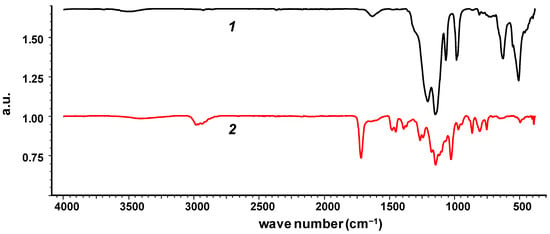
Figure 2.
IR spectra of the MK-2 bilayer membrane, showing the PFSA layer (1) and the copolymer layer (2).
Analysis of the IR spectrum reveals that the substrate membrane exhibits absorption bands corresponding to asymmetric stretching vibrations of SO3−, CF3−CF2−, and C-O-C groups (1310–1203 cm−1). A band at 1146 cm−1 indicates C-C bond vibrations. Two further bands, at 1063 and 982 cm−1, correspond to S-O-H, C-O-C bond vibrations and the symmetric vibrations of the SO3− group, respectively.
The anion exchange layer of the membrane shows absorption bands characteristic of the DADMAC and EMA copolymer. Stretching vibrations of C-H bonds in methyl and methylene groups appear in the region of 3030–2800 cm−1. The carbonyl group (C=O) stretching vibrations of the ethyl methacrylate ester fragment appear at 1720 cm−1. Carbon skeleton vibrations and bending vibrations of C-H, C-C, and C-O-C bonds are found in the region of 1500–400 cm−1.
The bilayer structure was established also by means of scanning electron microscopy (Figure 3).
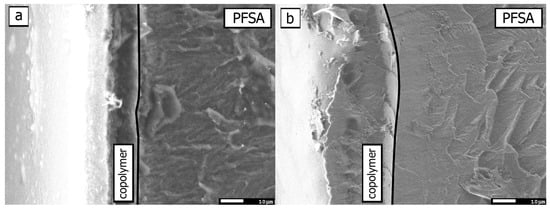
Figure 3.
Images of the cross-cut of bilayer membranes MK-1 (a) and MK-2 (b). The approximate interface is shown by the solid black line.
The concentration dependence of diffusion permeability for the homogeneous anion–exchange membrane MA-1 and specific electrical conductivity of the homogeneous cation-exchange membrane PFSA in sodium chloride and calcium chloride solutions is depicted in Figure 4.
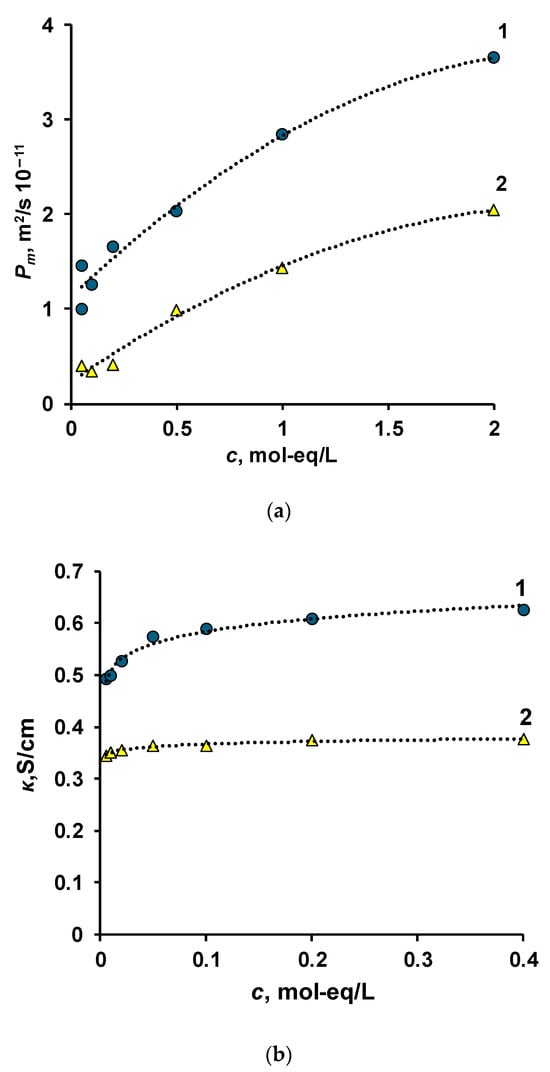
Figure 4.
Integral diffusion permeability coefficient of the MA-1 (a) and specific electrical conductivity of the PFSA (b) as a function of electrolyte concentration: 1—NaCl; 2—CaCl2.
The data show that sodium chloride diffuses through the MA-1 membrane at a higher rate than calcium chloride. These data were used to calculate the diffusion coefficients of co-ions in the MA-1 membrane (Supplementary S1, Equation (S6)) and the thin modifying layer, assuming that the properties of the membrane and the thin film are similar.
The electrical conductivity of the PFSA membrane is higher in sodium chloride solution compared to calcium chloride solution. These data were used to calculate the diffusion coefficients of counterions in the PFSA membrane (Supplementary S1, Equation (S5)).
Figure 5 shows calcium and sodium ion content in PFSA and MA-1 membranes. Note that sodium and calcium are counterions in the PFSA cation-exchange membrane, but co-ions in the MA-1 anion-exchange membrane.

Figure 5.
Sorption isotherms in the membrane/ternary solution system CaCl2 + NaCl (total concentration 0.03 mol-eq/L). Experimental data are shown by markers: 1—PFSA, 2—MA-1; lines represent calculations according to Equations (3) and (4).
Figure 5 clearly illustrates the distinct ion-exchange characteristics of the two membranes, consistent with their respective classifications. The cation-exchange membrane (PFSA) exhibits a pronounced preference for divalent ions, as evidenced by the higher uptake of calcium compared to sodium. This selectivity can be attributed to a combination of factors, including the strong affinity of calcium ions for the sulfonate groups present in the membrane and the enhanced electrostatic interactions between divalent cations and the fixed charged groups.
In contrast, the anion-exchange membrane (MA-1) displays a preference for monovalent ions. This behavior can be attributed to the electrostatic interactions between the co-ions (calcium and sodium) and the fixed charge groups within the membrane structure. As the co-ions and the fixed groups possess the same charge, ions with higher charge experience stronger electrostatic repulsion, leading to their more effective exclusion from the ion channels within the membrane.
From the experimental curves, we calculated the equilibrium constants for ion exchange: the Nikolsky constants for the cation-exchange membrane ( = 1.6) and the Donnan constants for the anion-exchange membrane ( = 0.7). These constants are expressed for the ratio of Ca2+ to Na+ ions.
Table 1 presents the experimentally obtained parameters of the electromembrane system.

Table 1.
Parameters of the electromembrane system.
3.2. Current–Voltage Curves
To investigate the electrochemical behavior of the ion exchange membranes in a mixed electrolyte environment, voltammetric measurements were carried out using a rotating membrane disk setup. Figure 6 presents the current–voltage curves obtained for the PFSA membrane substrate and the membranes MK-1 and MK-2, all immersed in a mixed solution containing 0.015 mol-eq/L NaCl and 0.015 mol-eq/L CaCl2. The measurements were conducted at a disk rotation speed of 100 rpm.
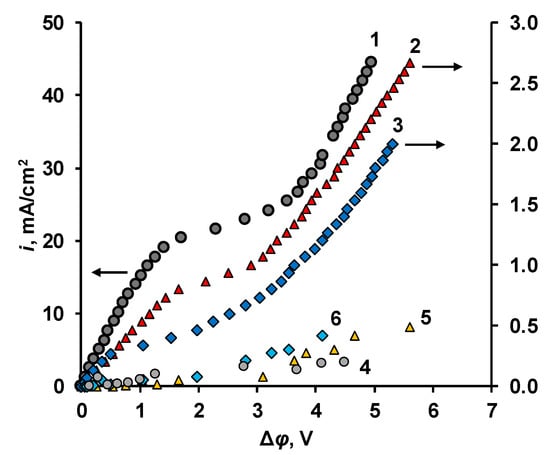
Figure 6.
Overall voltammetric characteristics and partial currents for water dissociation products of the studied membranes in a mixed solution containing 0.015 mol-eq/L NaCl and 0.015 mol-eq/L CaCl2 at a disk rotation speed of 100 rpm: 1–3—total voltammetric characteristics of PFSA, MK-1, and MK-2; 4–6—partial currents for hydroxide ions through PFSA, MK-1, and MK-2.
Figure 6 shows that applying an anion-exchange layer with a thickness of 6 μm (MK-1) to the homogeneous PFSA cation-exchange membrane reduces the limiting current density from 21 mA/cm2 to 0.80 mA/cm2. Increasing the anion-exchange layer thickness to 24 μm (MK-2) further decreases the limiting current density to 0.55 mA/cm2. This dependence of the current–voltage characteristics suggests the formation of an internal diffusion-limited current at the modifying layer/substrate membrane interface [].
Figure 7 presents the analysis of the limiting current dependence on diffusion layer thickness in Levich coordinates.
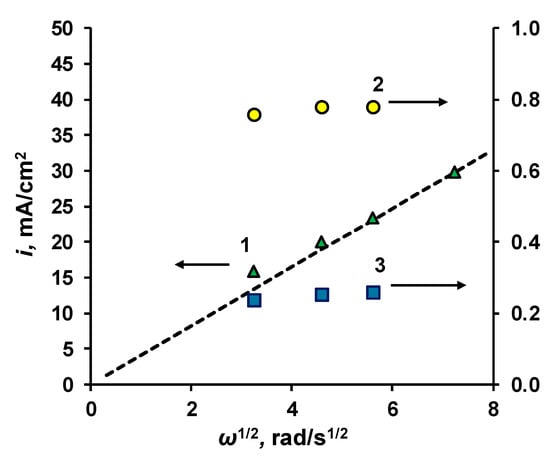
Figure 7.
Limiting current density as a function of the square root of the angular velocity of the rotating membrane disk in a mixed solution of 0.015 mol-eq/L NaCl and 0.015 mol-eq/L CaCl2. The dashed line represents the limiting current density values calculated using Equation (7). Experimental values of the limiting currents obtained using the tangent method for the membranes are shown by markers: 1—MF-4SK; 2—MK-1; 3—MK-2.
The total limiting current density () for the PFSA cation exchange membrane in the studied mixed solution is the sum of the partial limiting current densities for each counterion, neglecting co-ion transport through the membrane:
Superscript 0 indicates that the referenced concentration is in the bulk solution.
The results of our investigations, conducted at a range of rotation speeds for the membrane disk, indicate that the limiting current density remains constant regardless of the diffusion layer thickness for membranes MK-1 and MK-2 (Figure 6). This finding suggests that the overall limiting current within these membranes arises from the additive contributions of the partial currents of co-ions Na+ and Ca2+ through the modifying layer, along with the counterion Cl− through the substrate membrane:
Subscript “s” indicates that the referenced concentration is at the cation-exchanger/anion-exchanger boundary. The various tildes (~ and ¯) refer the corresponding parameter to the modifying layer or membrane substrate, as appropriate.
Given that the modifying layer thickness is significantly smaller than the substrate membrane thickness, the contribution of the third term in Equation (2) to the limiting current is at least an order of magnitude smaller than the contribution of the first two terms. Equation (2) can therefore be simplified as follows:
Analysis of the co-ion sorption isotherm for the modifying layer (Figure 4, curve 2) reveals that, while there is a greater affinity for sodium ions, the concentrations of calcium and sodium ions within the anion exchange membrane phase are relatively similar. This suggests that the limiting current for the bilayer membrane in the mixed solution is primarily governed by the ratio of the diffusion coefficients of the co-ions, (relative to the modifying layer), and the thickness of the modifying layer.
3.3. Specific Permselectivity
The ratio of ion fluxes during their competitive transport is typically determined by the permselectivity coefficient, which is generally expressed as follows:
A coefficient value greater than unity indicates that the membrane preferentially allows ion type 1 to pass through, resulting in a higher flux of this ion compared to ion 2. Conversely, a value less than unity signifies a greater flux of ion 2. Researchers are typically interested in the specific permeability of membranes for monovalent ions. Therefore, in the provided Equation (4), we will replace index 1 with Na+ ions and index 2 with Ca2+. Note that these designations are opposite to those adopted in our previous article [], where index 1 represented divalent ions.
Figure 8 depicts the relationship between the permselectivity coefficient for the Na+/Ca2+ pair and the dimensionless current density of MK-1 and MK-2 membranes.
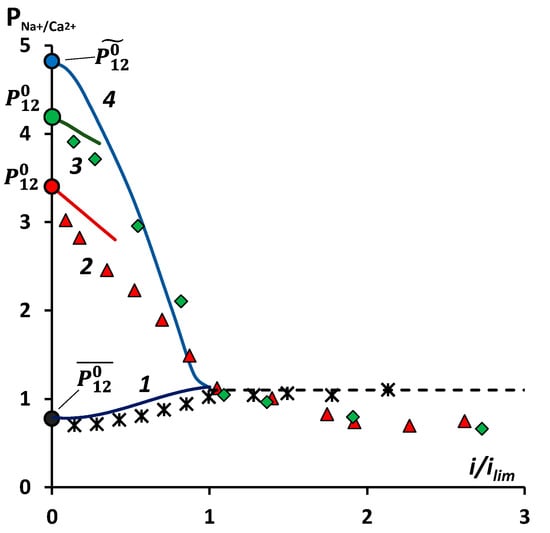
Figure 8.
Permselectivity coefficient as a function of dimensionless electric current density in a 0.015 mol-eq/L NaCl and 0.015 mol-eq/L CaCl2 mixed solution, with a membrane disc rotation speed of 100 rpm. Experimental data are marked, while the solid line represents calculations based on a four-layer mathematical model [], and the dashed line indicates the limiting value of the permselectivity coefficient determined by Equation (7). 1—PFSA, 2—MK-1, 3—MK-2, 4—MA-1.
As illustrated in Figure 8, the bilayer membranes MK-1 and MK-2 show a strong preference for allowing sodium ions to pass through compared to calcium ions. The thin modifying layer applied to the substrate membrane surface contains positively charged ionogenic groups (quaternary ammonium bases). Although these cations act as co-ions for the modifying layer, its thinness prevents significant resistance to their electrodiffusive flux. However, cations with higher charges are strongly repelled by the ionogenic groups within the ionic channels of the modifying layer, as a result their concentration inside the modifying layer is considerably lower than that of univalent cations []. Nevertheless, the diffusion coefficients of these ions within the modifying layer do not differ substantially, as indicated by the data in Table 1. Therefore, the resulting flux of monovalent ions is greater through the modifying layer and the bilayer membrane as a whole compared to the flux of divalent ions.
Notably, high specific selectivity is achieved even with a thin modifying layer. For instance, applying a 6 µm anion-exchange layer of copolymer results in a more than threefold increase in specific permeability for the monovalent sodium ion.
The permselectivity coefficients for the modifying layer () and the substrate membrane () are determined by kinetic characteristics (the ratio of diffusion coefficients for the separated ions in the modifying layer () and in the substrate membrane ()), thermodynamic characteristics–ion separation coefficients ( and ), and the ratio of ionic charges (z1 and z2) according to the following equations []:
Under equilibrium conditions (in the absence of external polarization), ion separation coefficients are equal to the corresponding thermodynamic equilibrium constants.
Using data obtained in this study, quasi-equilibrium permselectivity coefficients were calculated for the PFSA substrate membrane and the MA-1 modifying film, yielding values of = 0.7 and = 4.8, respectively.
As the current flowing through the membrane increases, not only does the composition of ions within the membrane change, but the membrane’s ability to selectively allow certain ions to pass through (its specific selectivity) also decreases. When the membrane reaches a limiting state, the selectivity coefficient () is solely determined by the rate at which the ions move through the solution (their diffusion coefficients) and the charges of the ions themselves []:
The permselectivity coefficients were calculated based on a previously developed four-layer mathematical model, using experimentally determined physicochemical and transport properties of the substrate membrane and modifying film.
The solid lines in Figure 7 represent the relationship between the specific permeability coefficients, calculated using a four-layer mathematical model, and the dimensionless current flowing through the membrane. Quasi-equilibrium specific permeability values () for modified membranes MK-1 and MK-2 were calculated using a four-layer mathematical model by extrapolating the dependence to i → 0. The quasi-equilibrium permselectivity coefficient for the bilayer membranes MK-1 and MK-2 was 3.4 and 4.2, respectively.
The original PFSA cation-exchange membrane and MA-1 anion-exchange film completely lose their ability to selectively allow different ions to pass through when a certain limit of current flow (the external diffusion-limited current) is reached. This behavior aligns with previous theoretical studies []. However, modified membranes present a different challenge. The limiting state in these membranes occurs at the interface between the modifying layer and the underlying membrane, and this limits the accuracy of the four-layer mathematical model when calculating the selectivity coefficient at high current densities (above ilim). This limitation arises because the difference in electric potential across this internal interface becomes infinitely large when the concentration of ions at this interface reaches zero, which happens when the current reaches the limiting value. To address this limitation and extend the model’s applicability to higher current densities, it is necessary to take into account the process of water dissociation (as demonstrated in studies [,]) and the formation of the space-charge region [].
3.4. Concentration of Sodium Chloride from Seawater
In the processes of electrodialysis concentration of seawater or reverse osmosis concentrates, special attention is given to the preferential transport of monovalent ions across membranes. This is primarily due to the risk of precipitate formation on the membranes during the operation of the electrodialyzer as ions such as Ca2+ and Mg2+ can form precipitates with a wide range of anions, including OH−, SO42−, CO32−, and F−. To minimize the risk of precipitation, the concentration of divalent ions in the concentrate should not exceed the solubility product of the sparingly soluble compounds and, ideally, should be minimized.
Figure 9 shows the kinetic curves for the increase in concentration of sodium chloride and calcium chloride in the cathode chamber of a rotating membrane disk setup using a PFSA membrane substrate and a bilayer MK-2 membrane.
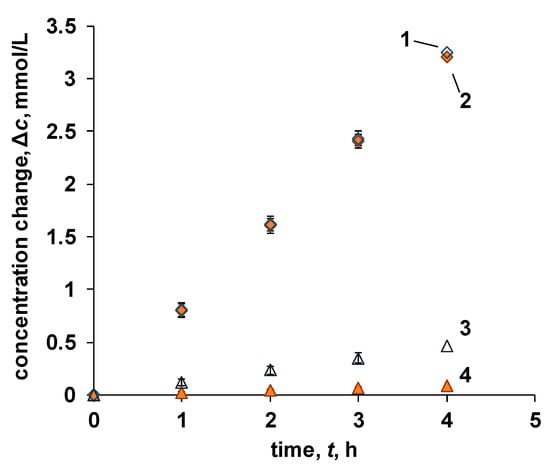
Figure 9.
Increase in the concentration of individual ions in the cathode chamber of the rotating membrane disk as a function of time. 1 and 3—concentration increase for sodium and calcium ions using the PFSA membrane, 2 and 4—concentration increase for sodium and calcium ions using the MK-2 membrane.
The data reveals a significant disparity in concentration between sodium and calcium ions in both electromembrane systems studied. This trend is directly linked to the nearly tenfold excess of sodium ions present in the feed water, which mimics the composition of the Black Sea. The PFSA membrane displays a higher calcium ion concentration in the cathode chamber, highlighting its greater specific selectivity for calcium ions (Figure 8). Notably, this membrane demonstrates a slightly higher overall cation transport number (0.85) compared to the MK-2 membrane (0.73), accounting for the marginally higher sodium ion concentration observed in the cathode chamber for the PFSA membrane.
The data suggest that the developed MK-2 bilayer membranes maintain high selectivity for monovalent ions even in highly concentrated solutions with a significant excess of one of the ions.
4. Conclusions
This study investigates the electrochemical and physicochemical properties of individual layers and composite bilayer ion-exchange membranes obtained by applying a previously developed DADMAC and EMA copolymer to the surface of a PFSA membrane. The bilayer membranes exhibit high selectivity for monovalent metal cations, particularly sodium. The specific permselectivity coefficient of the MK-2 bilayer membrane for sodium cations increases by more than six times (from 0.8 to 4.8) under the experimental conditions used in this paper.
A disadvantage of the membranes obtained is a significant decrease in the limiting current density, which is explained by the formation of a limiting state, not in the depleted diffusion layer adjacent to the membrane surface, but at the internal boundary of the cation exchanger and anion exchanger. This phenomenon imposes certain limitations on the range of applicable current densities and should be considered in the further development of processes and devices using the developed charge-selective membranes.
Calculations performed using a previously developed mathematical model qualitatively and quantitatively confirm the obtained experimental data. For the original PFSA membrane substrates, the calculation of the permselectivity coefficient across the entire current range up to values corresponding to the external diffusion limiting current is consistent with the experimental findings. For modified homogeneous membranes, the onset of a limiting state at the internal interface between the modifying layer and the substrate membrane limits the capabilities of the four-layer mathematical model for calculations of P1,2 at high current densities. To expand the operating range of current densities in the model, it is necessary to consider the process of water dissociation and the emergence of a space-charge region.
The developed homogeneous bilayer membranes with high chemical and electrochemical stability can be further used for the selective extraction and concentration of monovalent ions in multi-ionic solutions of strong electrolytes.
Supplementary Materials
The following supporting information can be downloaded at: https://www.mdpi.com/article/10.3390/electrochem5040026/s1, Supplementary S1—Methods; Supplementary S2—Four-layer mathematical model.
Author Contributions
Conceptualization, V.Z. and D.B.; methodology, A.A. and D.B.; investigation, A.A. and D.B.; resources, V.Z.; data curation, A.A. and S.M.; writing—original draft preparation, A.A. and D.B.; writing—review and editing, V.Z. and S.M.; visualization, A.A. and S.M.; project administration, V.Z.; funding acquisition, V.Z. All authors have read and agreed to the published version of the manuscript.
Funding
The study was supported by a grant from the Russian Science Foundation, No. 22-13-00439 (https://rscf.ru/project/22-13-00439/, accessed 19 September 2024).
Institutional Review Board Statement
Not applicable.
Informed Consent Statement
Not applicable.
Data Availability Statement
The data presented in this study are available on request from the corresponding author.
Acknowledgments
Cross-sectional images of the bilayer membranes were acquired at the “Structure and Properties of Nanomaterials” Shared Research Facility of Kuban State University.
Conflicts of Interest
The authors declare no conflicts of interest.
References
- Strathmann, H. Electrodialysis, a mature technology with a multitude of new applications. Desalination 2010, 264, 268–288. [Google Scholar] [CrossRef]
- Kemperman, A.J.B. (Ed.) Handbook Bipolar Membrane Technology; Twente University Press: Enschede, The Netherlands, 2000; ISBN 9036515203. [Google Scholar]
- Vermaas, D.A.; Veerman, J.; Saakes, M.; Nijmeijer, K. Influence of multivalent ions on renewable energy generation in reverse electrodialysis. Energy Environ. Sci. 2014, 7, 1434–1445. [Google Scholar] [CrossRef]
- Güler, E.; van Baak, W.; Saakes, M.; Nijmeijer, K. Monovalent-ion-selective membranes for reverse electrodialysis. J. Memb. Sci. 2014, 455, 254–270. [Google Scholar] [CrossRef]
- Chen, T.; Bi, J.; Sun, M.; Liu, J.; Yuan, J.; Zhao, Y.; Ji, Z. Electrodialysis metathesis for high-value resource conversion and recovery: From sustainable applications to future prospects. Chem. Eng. J. 2023, 473, 145299. [Google Scholar] [CrossRef]
- Wu, Q.; Liang, D.; Lu, S.; Wang, H.; Xiang, Y.; Aurbach, D.; Avraham, E.; Cohen, I. Advances and perspectives in integrated membrane capacitive deionization for water desalination. Desalination 2022, 542, 116043. [Google Scholar] [CrossRef]
- Li, X.; Zhang, H.; Mai, Z.; Zhang, H.; Vankelecom, I. Ion exchange membranes for vanadium redox flow battery (VRB) applications. Energy Environ. Sci. 2011, 4, 1147. [Google Scholar] [CrossRef]
- Qian, Y.; Huang, L.; Pan, Y.; Quan, X.; Lian, H.; Yang, J. Dependency of migration and reduction of mixed Cr2O72−, Cu2+ and Cd2+ on electric field, ion exchange membrane and metal concentration in microbial fuel cells. Sep. Purif. Technol. 2018, 192, 78–87. [Google Scholar] [CrossRef]
- Schmaljohann, D. Thermo- and pH-responsive polymers in drug delivery. Adv. Drug Deliv. Rev. 2006, 58, 1655–1670. [Google Scholar] [CrossRef]
- ter Veen, W.R.; Koene, L. Economic evaluation for an innovative electrochemical closed-loop purification system for industrial process liquids. Met. Finish. 2003, 101, 17–27. [Google Scholar] [CrossRef]
- Boucher, M.; Turcotte, N.; Guillemette, V.; Lantagne, G.; Chapotot, A.; Pourcelly, G.; Sandeaux, R.; Gavach, C. Recovery of spent acid by electrodialysis in the zinc hydrometallurgy industry: Performance study of different cation-exchange membranes. Hydrometallurgy 1997, 45, 137–160. [Google Scholar] [CrossRef]
- Díaz Nieto, C.H.; Palacios, N.A.; Verbeeck, K.; Prévoteau, A.; Rabaey, K.; Flexer, V. Membrane electrolysis for the removal of Mg2+ and Ca2+ from lithium rich brines. Water Res. 2019, 154, 117–124. [Google Scholar] [CrossRef] [PubMed]
- Ran, J.; Wu, L.; He, Y.; Yang, Z.; Wang, Y.; Jiang, C.; Ge, L.; Bakangura, E.; Xu, T. Ion exchange membranes: New developments and applications. J. Memb. Sci. 2017, 522, 267–291. [Google Scholar] [CrossRef]
- Khoiruddin; Ariono, D.; Subagjo; Wenten, I.G. Surface modification of ion-exchange membranes: Methods, characteristics, and performance. J. Appl. Polym. Sci. 2017, 134, 1–13. [Google Scholar] [CrossRef]
- Sata, T. Studies on ion exchange membranes with permselectivity for specific ions in electrodialysis. J. Memb. Sci. 1994, 93, 117–135. [Google Scholar] [CrossRef]
- Abdu, S.; Wessling, M.; Martí-Calatayud, M.-C.; Wong, J.E.; García-Gabaldón, M.; Wessling, M. Layer-by-Layer Modification of Cation Exchange Membranes Controls Ion Selectivity and Water Splitting. ACS Appl. Mater. Interfaces 2014, 6, 1843–1854. [Google Scholar] [CrossRef]
- Luo, T.; Abdu, S.; Wessling, M. Selectivity of ion exchange membranes: A review. J. Memb. Sci. 2018, 555, 429–454. [Google Scholar] [CrossRef]
- Ge, L.; Wu, B.; Yu, D.; Mondal, A.N.; Hou, L.; Afsar, N.U.; Li, Q.; Xu, T.T.; Miao, J.; Xu, T.T. Monovalent cation perm-selective membranes (MCPMs): New developments and perspectives. Chin. J. Chem. Eng. 2017, 25, 1606–1615. [Google Scholar] [CrossRef]
- Melnikov, S.; Bondarev, D.; Nosova, E.; Melnikova, E.; Zabolotskiy, V. Water Splitting and Transport of Ions in Electromembrane System with Bilayer Ion-Exchange Membrane. Membranes 2020, 10, 346. [Google Scholar] [CrossRef] [PubMed]
- White, N.; Misovich, M.; Yaroshchuk, A.; Bruening, M.L. Coating of Nafion membranes with polyelectrolyte multilayers to achieve high monovalent/divalent cation electrodialysis selectivities. ACS Appl. Mater. Interfaces 2015, 7, 6620–6628. [Google Scholar] [CrossRef]
- White, N.; Misovich, M.; Alemayehu, E.; Yaroshchuk, A.; Bruening, M.L. Highly selective separations of multivalent and monovalent cations in electrodialysis through Nafion membranes coated with polyelectrolyte multilayers. Polymer 2015, 103, 478–485. [Google Scholar] [CrossRef]
- Bondarev, D.; Melnikov, S.; Zabolotskiy, V. New homogeneous and bilayer anion-exchange membranes based on N,N-diallyl-N,N-dimethylammonium chloride and ethyl methacrylate copolymer. J. Memb. Sci. 2023, 675, 121510. [Google Scholar] [CrossRef]
- Achoh, A.R.; Zabolotsky, V.I.; Lebedev, K.A.; Sharafan, M.V.; Yaroslavtsev, A.B. Electrochemical Properties and Selectivity of Bilayer Ion-Exchange Membranes in Ternary Solutions of Strong Electrolytes. Membr. Membr. Technol. 2021, 3, 52–71. [Google Scholar] [CrossRef]
- Francis, M.J.; Pashley, R.M.; Rzechowicz, M. The effects of feed water de-gassing on the permeate flux of a small scale SWRO pilot plant. Desalin. Water Treat. 2011, 25, 150–158. [Google Scholar] [CrossRef]
- Gorobchenko, A.; Mareev, S.; Nikonenko, V. Mathematical Modeling of Monovalent Permselectivity of a Bilayer Ion-Exchange Membrane as a Function of Current Density. Int. J. Mol. Sci. 2022, 23, 4711. [Google Scholar] [CrossRef]
- Gorobchenko, A.D.; Gil, V.V.; Nikonenko, V.V.; Sharafan, M.V. Mathematical Modeling of the Selective Transport of Singly Charged Ions Through Multilayer Composite Ion-Exchange Membrane during Electrodialysis. Membr. Membr. Technol. 2022, 4, 423–432. [Google Scholar] [CrossRef]
- Femmer, R.; Mani, A.; Wessling, M. Ion transport through electrolyte/polyelectrolyte multi-layers. Sci. Rep. 2015, 5, 11583. [Google Scholar] [CrossRef]
- Golubenko, D.V.; Yaroslavtsev, A.B. Effect of current density, concentration of ternary electrolyte and type of cations on the monovalent ion selectivity of surface-sulfonated graft anion-exchange membranes: Modelling and experiment. J. Memb. Sci. 2021, 635, 119466. [Google Scholar] [CrossRef]
Disclaimer/Publisher’s Note: The statements, opinions and data contained in all publications are solely those of the individual author(s) and contributor(s) and not of MDPI and/or the editor(s). MDPI and/or the editor(s) disclaim responsibility for any injury to people or property resulting from any ideas, methods, instructions or products referred to in the content. |
© 2024 by the authors. Licensee MDPI, Basel, Switzerland. This article is an open access article distributed under the terms and conditions of the Creative Commons Attribution (CC BY) license (https://creativecommons.org/licenses/by/4.0/).